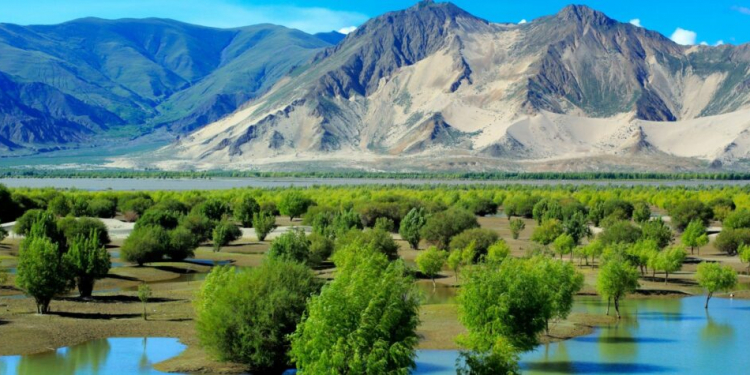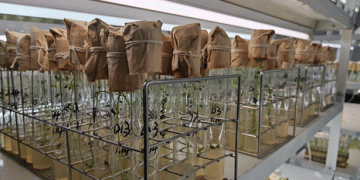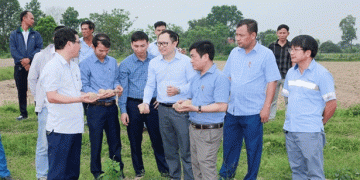The project is not the first time China has attempted to direct water to Xinjiang and relocate a greater number of Chinese migrants to southern Xinjiang.
The project aims to open desert areas for development, but experts say it could dilute the Uyghur population.

A secretive 500-kilometer-long irrigation project China is building to divert snowmelt from the Altay Mountains to desert areas in its restive Xinjiang region has developed a too-much-of-a-good-thing problem. Workers keep tapping into gushing flows of groundwater that have slowed construction to a crawl. Based in part on the 2,000-year-old karez (well) system designed by Uyghurs in Turpan (in Chinese, Tulufan), China began constructing the 514-kilometer-long (320-mile-long) project years ago in what is reportedly the longest underground irrigation canal system in the world.
The project comprises three deeply dug tunnels, the longest of which is the 280-kilometer-long (174-mile-long) Kashuang Tunnel — twice as long as the Delaware Aqueduct, the main channel supplying water to New York City. Despite the project’s size, China’s official media has yet to report on the irrigation network, which has given rise to a fair amount of speculation about what purpose the water line will ultimately serve, particularly as it is being built at a time of well-documented persecution against Uyghur Muslims who live in the area.
A few details first appeared in a scientific report by Deng Mingjiang, a Chinese academic at the Chinese Academy of Engineering, and his colleagues in February 2018. A second report he wrote for the Chinese peer-reviewed journal Tunnel Construction in November 2021 discussed the geological issues facing engineers.“The high level of groundwater has consistently led to flooding and had adverse effects on the construction plans,” according to the authors of the paper recently published in the Journal of Tunnel Construction.
Workers have been hit by strong streams of water, forcing them to flee the site. The problem is having a serious detrimental impact on construction, according to the Tunnel Construction report. The tunnel excavation rate has dropped to barely 200 meters (656 feet) per month, half the average rate in arid regions such as the Xinjiang, the journal article states. About 60 percent of the project had been completed as of June 2021, with experts believing that the ongoing flooding might lead to more significant delays in construction.
A Chinese team of engineers is now attempting to solve the problem. In one effort, they built an earthquake detector in the tunnel to anticipate the water flow on their excavation route so as to prepare for flooding, the report says. In addition to the problems caused by the complex geological conditions of the area, half of the project’s road calculation estimates, which were based on geological assessments, have turned out to be incorrect, according to the report.
‘Changing the ethnic balance’
The tunnel project seeks to divert water from the higher reaches of the Irtysh River, the source of which is snow from China’s Altay Mountains into the deserts of northern Xinjiang. The precise endpoint is not yet known. The river is an international waterway that flows through Xinjiang, Kazakhstan and Russia into the Arctic Sea. The river — the second-largest river in the Xinjiang — is fed by some 11 billion cubic meters (388.5 billion cubic feet) of snow per year, according to the Chinese government.
As engineers look to get the project back on track, much of the rest of the world is wondering what the Chinese government’s ultimate aim is in building it in the first place. Sean Roberts, director of the International Development Studies program at George Washington University and the author of the book The War on the Uyghurs: China’s Internal Campaign against a Muslim Minority, told RFA in December that the project could help to raise Xinjiang’s population of Han Chinese, the country’s national majority ethnic group, as a counterweight to Uyghurs.
“We know that the Chinese government is very interested in changing the ethnic balance in the Uyghur region in favor of Han Chinese, and one of the difficulties that has created is that it has required moving Uyghurs, Kazakhs and others out of the region because of the environment [there],” he said. “It would be impossible just to bring more people into the region, and that’s mostly because of the arid nature of the region,” Roberts said. “So, if they succeeded in irrigating this area with more water, that could theoretically expand the holding capacity of the region’s population.”
The project also has the potential for changing the demographics of Xinjiang for years to come, he said. “It could lead to many more Han being able to settle in the region and overwhelm those Uyghurs who remain in the region, so it could speed up the dispossession of Uyghurs and other indigenous peoples of this region [from] their connection to this particular land,” Roberts added.
The Chinese government sees the low population of Han Chinese, currently 8 percent in southern Xinjiang, as a security concern, according to an August 2021 report on Beijing’s population optimization strategy in southern Xinjiang by German researcher Adrian Zenz.
Agriculture, industry, mining
Stanley Toops, a cultural geographer at Miami University in Ohio, whose research focuses on the Xinjiang Uyghur Autonomous Region, said the giant irrigation system could also be an economic development tool. “It could be that they want to do agriculture or industry, or maybe some mining or there are minerals. Then, they [would] need water to expand the settlement. But currently, this area is a dry desert area, so there’s no water.”

Part of the outside interest in the project is due to the fact that it is being built at a time when Western countries, the United Nations and human rights groups have condemned China over its mass internment campaign begun in the region in 2017 that has seen an estimated 1.8 million mostly Muslim Uyghurs and other Turkic minorities detained in internment camps.
Credible testimonies and well-documented reports also point to other rights abuses involving Uyghurs, including intrusive surveillance systems, the torturing of detainees, forced sterilizations of Uyghur women, the use of Uyghur forced labor, and the transfer of Han Chinese into the region. The project is not the first time China has attempted to direct water to Xinjiang and relocate a greater number of Chinese migrants to southern Xinjiang. In an earlier project, Chinese researchers planned to build a 1,000-kilometer tunnel to divert water from the Yarlung Tsangpo River in the Tibetan Plateau to the Tarim Basin.






